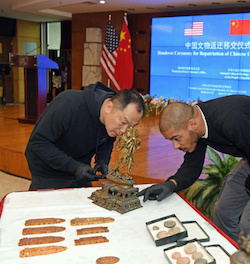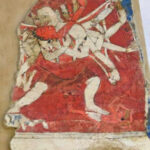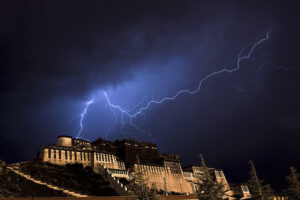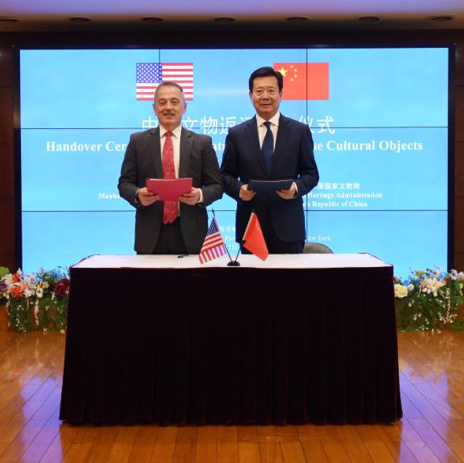
Handover Ceremony for Chinese Cultural Objects, Xinhua.
The New York District Attorney’s Office Anti-Trafficking Unit (ATU) has returned 38 ‘cultural relics,’ identified as Buddhist religious objects from Tibet to the communist government of the People’s Republic of China. The returned objects were said to include Tibetan Buddhist artifacts from the Mongol-led Yuan (1279-1368), Ming (1368-1644) and Qing (1644-1912) dynasties. However, art experts shown photographs by Cultural Property News questioned the attributions and ages. (The ATU describes any returned object as a ‘treasure.’) The returned objects also included a bronze dorje, ivory carvings, wooden sculptures, and fragments of murals.
The return by Assistant NY District Attorney Matthew Bogdanos, an aggressive advocate of repatriation, seems designed to curry favor with the PRC and give it a propaganda victory. Bogdanos signed papers with PRC Deputy Minister of Culture and Tourism and head of the National Cultural Heritage Administration Li Qun at a handover ceremony held at the Chinese Consulate General in New York. The return was little noted in the U.S. but celebrated by multiple articles in the Chinese press. The Chinese articles claimed that this return of “Chinese cultural objects” marks a new high in U.S.-China cultural relations.

Returned wallpainting fragment. Xinhua.
Neither the Manhattan DA nor the Chinese government has stated how the seizure of the objects in March 2024 was justified in the first place. Whatever the reason for the seizure or the authenticity of the objects, the return should be taken seriously as a violation of key principles of U.S. cultural policy.
A letter from Lama Wangchuk Gyaltsen, a distinguished elder of the Tibetan community, to DA Alvin Bragg and congressional and NY State legislators makes plain the concerns of Tibetans in the United States:
I am shocked and surprised to learn that Mr. Alvin Bragg, District Attorney of New York County, recently returned 38 religious and cultural artifacts of Tibet to the communist government of China, who illegally occupied our free Tibet by brutal force and plundered our monastic institutions during the cultural revolution.
Moreover, the present Chinese government is systematically destroying every facet of Tibetan cultural heritage including language, beliefs, culture and traditions through boarding schools; sinicization of educational institutions, monasteries and nunneries, depriving Tibetans in Tibet their basic human rights and making possession of His Holiness the Dalai Lama’s photo a crime punishable with long prison sentences.
The US government, in particular the State Department is thoroughly aware of the Chinese government’s inhumane actions and policies in Tibet as manifested in their annual human rights reports. But a bureau under it returned the Tibetan cultural artifacts to the occupying government!!!
We, the Tibetan people demand the State Department explain this egregious action and assure us no Tibetan cultural artifacts will be repatriated to the Chinese government until they resolve the Tibet issue through negotiation with the representatives of His Holiness the Dalai Lama or with the elected leaders of Tibetan people.
The preservation of Tibetan cultural heritage benefits both the Tibetans and the world at large as it greatly contributes to world peace and prosperity. As our culture is based on peace and nonviolence, it is quintessential for furthering peace and humane understanding in a world torn by divisions. We need to preserve our cultural heritage for generations to come as it is in the interest of the world.
Lama Wangchuk Gyaltsen
Elder leader of Tibetan Association of Santa Fe
Since the brutal occupation of Tibet, U.S. authorities have accepted that Tibetan artifacts belong to the Tibetan people, not the Chinese government. The Dalai Lama has made clear that Tibetan art is safer in U.S. museums and collections than in Chinese hands, through his personal visits to museums where Tibetan objects have been housed and expressions of appreciation for the preservation of Tibetan culture.
His Holiness the Dalai Lama wrote regarding a Tibetan shrine recently donated to the Minneapolis Museum of Art,
“I am very happy to know that some of our sacred images have survived and are being treated with appropriate respect elsewhere. I am grateful to Alice Kandell not only for collecting and carefully preserving the objects… that approximates the way they would have been revered in Tibet, but also for sharing them with the general public.”
Tibetan objects have not previously been returned to China under U.S. laws such as the Cultural Property Implementation Act. However, a recently renewed State Department Memorandum of Agreement (MOU) with the PRC recognizes the rights of China’s authoritarian Communist Government to the cultural heritage of its repressed minority Tibetan and Uyghur populations. Agreements promoted by the State Department’s Cultural Heritage Center at the Bureau of Educational and Cultural Affairs (ECA) were first signed in 2009, despite significant opposition from U.S. cultural institutions and have been regularly renewed despite protests by U.S. domestic interests advocating for Tibetan and Uyghur religious minorities within China.

Lightning over the Potala Palace in Lhasa, Tibet, Author: 李国强, 11 August 2011, Creative Commons Attribution-Share Alike 3.0 Unported license.
In contrast, the State Department’s Bureau of Democracy, Human Rights, and Labor, which champions American values, has been highly critical of China’s oppression of its religious and cultural minorities. Other elements of the U.S. government also support human rights and civil freedoms in Tibet. The “Resolve Tibet Act” pending now before Congress would be an important step in recognizing Tibet as an occupied country whose legal status remains to be resolved under international law. The House of Representatives passed this bill on February 15 with a huge majority, 392 to 28; the Senate Foreign Relations Committee approved it on April 16, paving the way for rapid Senate passage. Once signed, this bill will send a message of hope to Tibetan and other oppressed minorities striving for freedom in China.
China’s continuing occupation of Tibet violates the principles of the U.S. International Religious Freedom Act of 1998 (IRFA) as well as the UN Charter. The mistreatment of religious minorities and their cultural heritage is not only a violation of human rights under international law – it stands in direct contrast to China’s duty to preserve cultural heritage under the 1970 UNESCO Convention, which is implemented in the U.S. by the Cultural Property Implementation Act. The U.S.-China MOU under this Act is the Manhattan DA’s purported justification for giving Tibetan artifacts to China.

Tibetan monks arrested after protest. Students for a Free Tibet. Wikimedia Commons.
Tibet was forcibly joined to the People’s Republic of China after an invasion by Chinese forces starting in 1950. The Dalai Lama fled to India in the wake of the Lhasa Uprising against a brutal Chinese occupation in 1959. Between the 1950s through the Cultural Revolution ending in 1976, 1.2 million Tibetans were killed and all but 13 of the country’s 6,254 monasteries were destroyed. The number of nuns and monks in Tibet was reduced by 93 percent.
Today in Tibet, under Chinese President Xi Jinping’s increasingly authoritarian rule, it is illegal for parents to teach children religion or participate in religious celebrations. A U.S. State Department analysis shows that a million Tibetan children as young as toddlers have been taken into locked boarding schools where they are indoctrinated and not even allowed to speak their own language.
China forces Buddhist monks and nuns to use “translated” approved religious texts in Mandarin in which Buddhism supports China’s Communist Party. In a bizarre contradiction of communist denial of religion, China’s government has banned reincarnation without government approval since 2007. According to the United States Commission on International Religious Freedom, China even claims the right to choose the next reincarnation of His Holiness the Dalai Lama.
It is unconscionable to return Tibetan religious objects to the control of a government that has attempted to erase Tibetan culture.

Dalai Lama speaks to a large crowd on the National Mall in Washington DC. Photo by Jeff Tinsley, 2000, Wikimedia Commons.
His Holiness the Dalai Lama has many times stressed the importance of preserving Tibetan culture despite the efforts of China to erase its monuments and destroy Tibet’s history as an autonomous country. He has championed the creation of monastic institutions and archives for the preservation of ancient books. China’s repression of Tibetan culture inside Tibet has made clear the necessity of preserving it in the diaspora. outside of Tibet by promoting the building of schools of Tibetan language, religious scholarship, traditional medicine and even music and dance.
For more than fifty years, the Dalai Lama has been the most prominent voice for the preservation of Tibetan culture, encouraging the collection of Tibetan artifacts in U.S. museums and the establishment of Tibetan-organized long-term cultural institutions such as Tibet House US “to ensure the survival of Tibetan civilization and culture.” Instead of Tibetan objects being presented to the oppressors and destroyers of Tibetan culture, they should be held in safe harbor until they can return to a free and secure Tibet.
 Handover Ceremony for Chinese Cultural Objects, NY County Assistant District Attorney Matthew Bogdanos and PRC Deputy Minister of Culture and Tourism and head of the National Cultural Heritage Administration Li Qun. Xinhua.
Handover Ceremony for Chinese Cultural Objects, NY County Assistant District Attorney Matthew Bogdanos and PRC Deputy Minister of Culture and Tourism and head of the National Cultural Heritage Administration Li Qun. Xinhua. 

